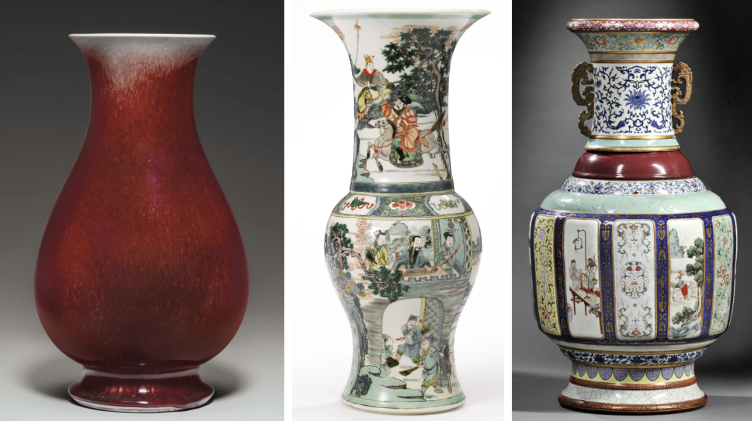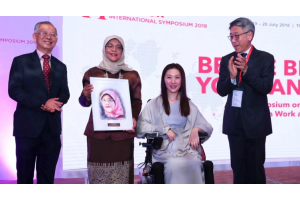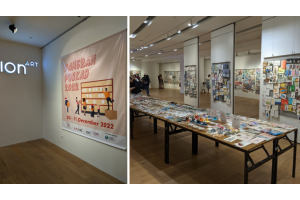Understanding Chinese Ceramics In The Qing Dynasty
-
December 13, 2022
Informational

Written by: Tang Kai Xian
The peak of Chinese ceramic production was seen in the Qing Dynasty’s Kangxi (1661–1722), Yongzheng (1722–1735), and Qianlong (1735–1795) period. Significant improvement was made across most ceramic types, such as the blue and white wares, monochrome wares, etc. Strides in technological advancement led to new colours and more intricate designs. The Jingdezhen region saw a revival, having previously been destroyed during the fall of the Ming dynasty. They established more kilns and workshops as demand from the Imperial Palace and temples saw a resurgence. Here are some of the ceramics produced then,
Langyao 郎窯

Christie’s (2017). A Langyao Vase, Pipa Zun. Available at https://www.christies.com/en/lot/lot-6096864
Langyao derives its name from Lang Tingji, director of the official kilns at Jingdezhen between 1705-1712. He is credited with the revival of monochrome glazes, especially copper-red glazes. These appear to have been attempts to recreate red glaze of the famous Ming Dynasty Xuande Period (1425-35).
Doucai 斗彩

Sotheby’s (2009). A fine and rare Doucai 'Chicken' cup Qing Dynasty, Qianlong Period. Available at https://www.sothebys.com/en/auctions/ecatalogue/2009/fine-chinese-ceramics-works-of-art-hk0308/lot.1612.html
Doucai literally means contrasting colours. Like Langyao ceramics, it also originated from the Ming Dynasty Xuande period (1425-35). The contrasting colours are developed during the firing process.
Wucai 五彩

Sotheby’s (2014). A Wucai Phoenix-Tail Vase Qing Dynasty, Kangxi Period. Available at https://www.sothebys.com/en/auctions/ecatalogue/2014/kangxi-porcelain-n09110/lot.18.html
Wucai means five colour ware. But in reality it consists mostly of three enamels (red, green and yellow) within outlines in blackish dry cobalt, underglaze blue, plus the white of the porcelain body. In later designs, black and gold was used to outline the design. Their decorative patterns often included finely painted motifs and symbols of dragons, fish, flowers, etc. The finest production of Wucai ceramics was in the Qing Dynasty Kangxi period (1661-1722).
Falangcai 珐琅彩

Christie’s (2019). A Fine and Extraordinary Imperial Ruby Red-Ground Falangcai 'Double Lotus' Bowl. Available at https://www.christies.com/en/lot/lot-6242463
Falangcai can be translated as foreign colours. The production of Falangcai started in the 35th year of the Kangxi reign (1696) and was made exclusively for the imperial court and royal family. Its production was limited due to its high cost. Today, Falangcai porcelains are among the rarest and most dazzling ceramic wares of the Qing Dynasty and are still highly coveted among collectors. Some finest examples could fetch up to 25 million USD at auctions.
While most Imperial ware were made in kilns in Jingdezhen, Falangcai porcelains were made in the Imperial workshop of the Forbidden City in Beijing. It was developed with the knowledge from scholars and artists from the west who brought with them scientific instruments and new enamelling techniques.
Fencai 粉彩; Famille Rose

Bonhams Skinner. Fencai, Imperial Qianlong period vase. Available at https://www.skinnerinc.com/auctions/2751B?saleno=2751B&lot=96
Fencai means ‘soft colours’. It is mixed with iron powder and a substance called po li bai;玻璃白 (‘Glass white’). Famille rose enamel ware gave rise to a greater range of colour and tone than was previously possible, enabling the illustrations of more elaborate images such as insects.
Conclusion
The revival of the ceramics industry in the Qing Dynasty played a major role in the Qing economy’s economic prosperity. Innovations in its creative aspects generated demand in the West.
Today, Qing Dynasty ceramics can be found at auctions and museums. Once in a while, some rare Qing Dynasty ceramics would surface and break auction records. However, for every genuine piece, there are many forgeries. The most widely known authenticity test is the thermoluminescence test, or TL test, which is used on some types of ceramic to estimate, roughly, the date of last firing. Thermoluminescence dating is carried out on small samples of pottery drilled or cut from the body of a piece, which can be risky and disfiguring. For this reason, the test is rarely used for dating finely potted, high-fired ceramics. TL testing cannot be used at all on some types of ceramics, particularly high-fired porcelain. Another method to authenticate a piece is to check reign marks. The mark is four to six Chinese characters long. It records the name of the dynasty and emperor active when the porcelain was produced.
References:
Adapted from material titled Ceramics in Chinese History; The Imperial and Folk Kilns in Qing Dynasty. By Francis Li Chung-hung - Fellow, Royal Asiatic Society of Great Britain and Ireland.
https://www.comuseum.com/ceramics/qing/
https://www.chineseantiques.co.uk/what-is-wucai-porcelain/
https://en.thevalue.com/articles/yongzheng-famille-rose-quali-bowls-bonhams
https://www.christies.com/features/A-magnificent-falangcai-bowl-10179-3.aspx


 PREVIOUS ARTICLE
PREVIOUS ARTICLE 






